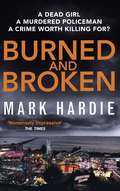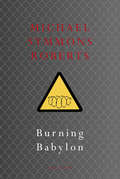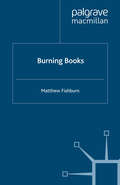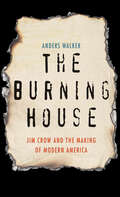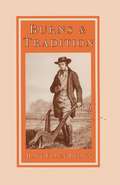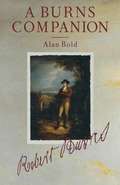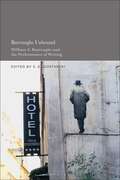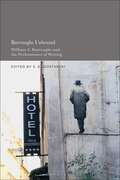- Table View
- List View
The Burley manuscript (The Manchester Spenser)
by Peter RedfordThe Burley manuscript is a miscellany compiled in the late sixteenth and early seventeenth century, unique in size and variety. In this study, annotated transcriptions are given of all of the private letters in English and all the English verse. Incipit transcriptions and identification are provided for each of the other items, including those in foreign languages. The history and provenance of the collection are described in detail, with lengthy notes on memorial transcription of verse and prose, and the clandestine interception of letters. The book makes available texts, annotations and commentary that will have an impact on a wide range of scholarship. It will be found useful to literary scholars, editors, and social historians, illuminating such diverse subjects as the circulation of verse, the correspondence of John Donne, the self-fashioning of English gentlemen after the classical Romans of their class and the government's paranoiac spying on its own citizens.
Burmese: A Comprehensive Grammar (Routledge Comprehensive Grammars)
by Mathias Jenny San San Hnin TunBurmese: A Comprehensive Grammar is a complete reference guide to modern Burmese grammar. It presents a fresh and thorough description of the language, concentrating on the real patterns of use in modern Burmese. The volume is organized to promote a thorough understanding of Burmese grammar. It offers a stimulating analysis of the complexities of the language, with clear explanations. Throughout, the emphasis is on Burmese as used by present-day native speakers. Features include: detailed treatment of the common grammatical structures and parts of speech particular attention to areas of confusion and difficulty all examples given in Burmese script, IPA phonetic transcription, and English glossary of linguistic terminology The Grammar is the ideal reference source for intermediate to advanced learners and users of Burmese and will remain the standard reference work for years to come.
Burned and Broken: A gripping detective mystery you won't be able to put down (Pearson and Russell)
by Mark HardieA gripping mystery about a woman trying to find out the truth behind the death of her best friend and introducing a brilliant detective duo - perfect for fans of Peter James, Angela Marsons and James Oswald. A DEAD GIRLA vulnerable young woman, fresh out of the care system, is trying to discover the truth behind the sudden death of her best friend.A MURDERED POLICE OFFICERThe charred body of a policeman - currently the subject of an internal investigation - is found in the burnt-out-shell of his car on the Southend seafront.A CRIME WORTH KILLING FOR?To DS Frank Pearson and DC Catherine Russell of the Essex Police Major Investigation Team, the two events seem unconnected. But as they dig deeper into their colleague's murder, dark secrets begin to emerge.Can Pearson and Russell solve both cases, before more lives are destroyed?A twisty, gripping novel that introduces a brilliant new detective duo. If you like Peter James, Angela Marsons, James Oswald, LJ Ross, Joy Ellis and Patricia Gibney, then you'll love this crime debut.****Praise for Burned and Broken:'Immensely impressive' The Times'The investigation into a copper's dramatic death in downbeat Southend scoops a cast of equally downbeat characters into its net, and tensions rise as their stories fold around each other. An accomplished debut' Sunday Times'Emotional, intelligent, sensual and with such a strong voice, Burned and Broken by Mark Hardie is a crime debut that deserves huge success' Harry Illingworth (Goldsboro Books)'I absolutely LOVED, LOVED, LOVED this book and I would recommend it to anybody. I can't wait to read more investigations led by DS Frank Pearson and DC Cat Russell' Amanda Oughton (Ginger Book Geek)'The story is easy to follow without being too simple, and the novel really manages to evoke a sense of atmosphere and reality within its pages. I didn't find myself becoming distracted whilst reading at all, and raced through it in hours. I will certainly be reading any future novels, particularly in this series which I wholeheartedly enjoyed' Laura Naz (Snazzy Books)
Burnin' Daylight: Building a Principle-Driven Writing Program
by Ryan J. DippreRooted in contemporary understandings of social action, informed by up-to-date research on writing program administration, and attentive to the needs of value-driven decision-making, Burnin’ Daylight enables writing program administrators (WPAs) to shape writing programs that help people create the lives they envision. This book guides WPAs through the rough terrain of running a writing program during a period of sustained social and economic upheaval—and through the process of making their programs more principle-driven and sustainable along the way. WPAs face a range of challenges on a regular basis: organizing class schedules, leading professional learning events, conducting program assessments, responding to student needs, meeting with deans and provosts, and more. Additionally, WPAs need to learn about and direct their programs strategically when considering the kind of program they currently have, the sort of program they envision, and how they can transition from one to another. Burnin’ Daylight acts as a roadmap for IRB-approved research and provides WPAs—specifically, new and returning WPAs—with a detailed yet flexible plan for understanding the inner workings of a writing program and how to develop a future trajectory for it. Burnin’ Daylight is for writing program administrators of all experience levels and other administrators interested in taking a “principled practices” approach to their work.
Burning Babylon
by Michael Symmons RobertsIn his first two collections - Soft Keys and Raising Sparks - Michael Symmons Roberts established himself as a lyric and dramatic poet with metaphysical concerns. In this new collection, those concerns are as strong as ever, but rooted in a specific place and time. These poems describe the personal and public rise and fall of Greenham Common. The public story, as one of the most contentious missile bases of the cold war, ended with fences removed, buildings demolished, the base returned to common land. The private history emerges from the poet's own experience, as an adolescent living a mile away from Greenham Common at the height of its powers. That third community of locals - not the USAF or the peace camps - is finally given a voice in Burning Babylon.This is war poetry, but from an undeclared war in which battle lines were unclear, secrecy was an obsession, and threat was the chief weapon. At the heart of it all was that real and mythic gated city - the base - which was both a key part of the poet's childhood landscape, and the prime nuclear target in Britain. This image of a huge, occult and lethal power latent behind wire in the middle of England has haunted the minds of a generation - just as the poems in this book will resonate long after it is laid aside.
Burning Books
by M. FishburnThis provocative new work examines the years between the Nazi book fires and the publication of Ray Bradbury's Fahrenheit 451 (1953), a period when book burning captured the popular imagination. It explores how embedded the myths of book burning have become in our cultural history, and illustrates the enduring appeal of a great cleansing bonfire.
Burning Down the House: Latin American Comics in the 21st Century. (Global Perspectives in Comics Studies)
by Laura Cristina Fernández Amadeo Gandolfo Pablo TurnesBurning Down the House explores the political, economic and cultural landscape of 21st-century Latin America through comics. It examines works from Argentina, Brazil, Bolivia, Chile, Uruguay, Perú, Colombia, México and Spain, and the resurgence of comics in recent decades spurred by the ubiquity of the Internet and reminiscent of the complex political experiences and realities of the region. The volume analyses experimentations in themes and formats and how Latin American comics have become deeply plural in its inspirations, subjects, drawing styles and political concerns while also underlining the hybrid and diverse cultures they represent. It examines the representative and historical images in a state of emergency and political upheaval; decolonial perspectives and social struggles linked to ethnic and sexual minorities. It looks at how Latin American comics are made right now – from a diverse and autochthonous Latin American perspective. With a wide array of illustrations, this book in the Global Perspectives in Comics Studies series will be an important resource for scholars and researchers of comic studies, Latin American studies, cultural studies, English literature, political history and post-colonial studies.
Burning Down the House: Latin American Comics in the 21st Century. (Global Perspectives in Comics Studies)
by Laura Cristina Fernández Amadeo Gandolfo Pablo TurnesBurning Down the House explores the political, economic and cultural landscape of 21st-century Latin America through comics. It examines works from Argentina, Brazil, Bolivia, Chile, Uruguay, Perú, Colombia, México and Spain, and the resurgence of comics in recent decades spurred by the ubiquity of the Internet and reminiscent of the complex political experiences and realities of the region. The volume analyses experimentations in themes and formats and how Latin American comics have become deeply plural in its inspirations, subjects, drawing styles and political concerns while also underlining the hybrid and diverse cultures they represent. It examines the representative and historical images in a state of emergency and political upheaval; decolonial perspectives and social struggles linked to ethnic and sexual minorities. It looks at how Latin American comics are made right now – from a diverse and autochthonous Latin American perspective. With a wide array of illustrations, this book in the Global Perspectives in Comics Studies series will be an important resource for scholars and researchers of comic studies, Latin American studies, cultural studies, English literature, political history and post-colonial studies.
The Burning House: Jim Crow and the Making of Modern America
by Anders WalkerA startling and gripping reexamination of the Jim Crow era, as seen through the eyes of some of the most important American writers In this dramatic reexamination of the Jim Crow South, Anders Walker demonstrates that racial segregation fostered not simply terror and violence, but also diversity, one of our most celebrated ideals. He investigates how prominent intellectuals like Robert Penn Warren, James Baldwin, Eudora Welty, Ralph Ellison, Flannery O’Connor, and Zora Neale Hurston found pluralism in Jim Crow, a legal system that created two worlds, each with its own institutions, traditions, even cultures. The intellectuals discussed in this book all agreed that black culture was resilient, creative, and profound, brutally honest in its assessment of American history. By contrast, James Baldwin likened white culture to a “burning house,” a frightening place that endorsed racism and violence to maintain dominance. Why should black Americans exchange their experience for that? Southern whites, meanwhile, saw themselves preserving a rich cultural landscape against the onslaught of mass culture and federal power, a project carried to the highest levels of American law by Supreme Court justice and Virginia native Lewis F. Powell, Jr. Anders Walker shows how a generation of scholars and judges has misinterpreted Powell’s definition of diversity in the landmark case Regents v. Bakke, forgetting its Southern origins and weakening it in the process. By resituating the decision in the context of Southern intellectual history, Walker places diversity on a new footing, independent of affirmative action but also free from the constraints currently placed on it by the Supreme Court. With great clarity and insight, he offers a new lens through which to understand the history of civil rights in the United States.
Burning Man: The Ascent of DH Lawrence
by Frances Wilson'Frances Wilson writes books that blow your hair back. She makes Lawrence live and breathe, annoy and captivate you … she conjures the past with such clarity and wit and flair that it feels utterly present' Katherine Rundell 'A brilliantly unconventional biography, passionately researched and written with a wild, playful energy' Richard HolmesD H Lawrence is no longer censored, but he is still on trial – and we are still unsure what the verdict should be, or even how to describe him. History has remembered him, and not always flatteringly, as a nostalgic modernist, a sexually liberator, a misogynist, a critic of genius, and a sceptic who told us not to look in his novels for 'the old stable ego', yet pioneered the genre we now celebrate as auto-fiction. But where is the real Lawrence in all of this, and how – one hundred years after the publication of Women in Love - can we hear his voice above the noise? Delving into the memoirs of those who both loved and hated him most, Burning Man follows Lawrence from the peninsular underworld of Cornwall in 1915 to post-war Italy to the mountains of New Mexico, and traces the author's footsteps through the pages of his lesser known work. Wilson's triptych of biographical tales present a complex, courageous and often comic fugitive, careering around a world in the grip of apocalypse, in search of utopia; and, in bringing the true Lawrence into sharp focus, shows how he speaks to us now more than ever.'No biography of Lawrence that I have read comes close to Burning Man' Ferdinand Mount, author of Kiss Myself Goodbye'The most original voice in life-writing today' Lucasta Miller, author of Keats
Burning Man: The Ascent of DH Lawrence
by Frances Wilson'Frances Wilson writes books that blow your hair back. She makes Lawrence live and breathe, annoy and captivate you … she conjures the past with such clarity and wit and flair that it feels utterly present' Katherine Rundell 'A brilliantly unconventional biography, passionately researched and written with a wild, playful energy' Richard HolmesD H Lawrence is no longer censored, but he is still on trial – and we are still unsure what the verdict should be, or even how to describe him. History has remembered him, and not always flatteringly, as a nostalgic modernist, a sexually liberator, a misogynist, a critic of genius, and a sceptic who told us not to look in his novels for 'the old stable ego', yet pioneered the genre we now celebrate as auto-fiction. But where is the real Lawrence in all of this, and how – one hundred years after the publication of Women in Love - can we hear his voice above the noise? Delving into the memoirs of those who both loved and hated him most, Burning Man follows Lawrence from the peninsular underworld of Cornwall in 1915 to post-war Italy to the mountains of New Mexico, and traces the author's footsteps through the pages of his lesser known work. Wilson's triptych of biographical tales present a complex, courageous and often comic fugitive, careering around a world in the grip of apocalypse, in search of utopia; and, in bringing the true Lawrence into sharp focus, shows how he speaks to us now more than ever.'No biography of Lawrence that I have read comes close to Burning Man' Ferdinand Mount, author of Kiss Myself Goodbye'The most original voice in life-writing today' Lucasta Miller, author of Keats
Burning the Books
by Richard OvendenThe director of the famed Bodleian Libraries at Oxford narrates the global history of the willful destruction—and surprising survival—of recorded knowledge over the past three millennia.Libraries and archives have been attacked since ancient times but have been especially threatened in the modern era. Today the knowledge they safeguard faces purposeful destruction and willful neglect; deprived of funding, libraries are fighting for their very existence. Burning the Books recounts the history that brought us to this point.Richard Ovenden describes the deliberate destruction of knowledge held in libraries and archives from ancient Alexandria to contemporary Sarajevo, from smashed Assyrian tablets in Iraq to the destroyed immigration documents of the UK Windrush generation. He examines both the motivations for these acts—political, religious, and cultural—and the broader themes that shape this history. He also looks at attempts to prevent and mitigate attacks on knowledge, exploring the efforts of librarians and archivists to preserve information, often risking their own lives in the process.More than simply repositories for knowledge, libraries and archives inspire and inform citizens. In preserving notions of statehood recorded in such historical documents as the Declaration of Independence, libraries support the state itself. By preserving records of citizenship and records of the rights of citizens as enshrined in legal documents such as the Magna Carta and the decisions of the US Supreme Court, they support the rule of law. In Burning the Books, Ovenden takes a polemical stance on the social and political importance of the conservation and protection of knowledge, challenging governments in particular, but also society as a whole, to improve public policy and funding for these essential institutions.
Burning Women: Widows, Witches, and Early Modern European Travelers in India (Early Modern Cultural Studies 1500–1700)
by P. BanerjeeIn early modern Europe, the circulation of visual and verbal transmissions of sati, or Hindu widow burning, not only informed responses to the ritualized violence of Hindu culture, but also intersected in fascinating ways with specifically European forms of ritualized violence and European constructions of gender ideology. European accounts of women being burned in India uncannily commented on the burnings of women as witches and criminal wives in Europe. When Europeans narrated their accounts of sati, perhaps the most striking illustration of Hindu patriarchal violence, they did not specifically connect the act of widow burning to a corresponding European signifier: the gruesome ceremonial burnings of women as witches. In examining early modern representations of sati, the book focuses specifically on those strategies that enabled European travellers to protect their own identity as uniquely civilized amidst spectacular displays of 'Eastern barbarity'.
A Burns Companion (Literary Companions)
by Alan BoldThis Companion, designed as an authoritative biographical and critical guide to Burns, is in six sections. Part I places Burns in context with a Chronology, 'The Burns Circle' and a Topography. Part II looks at the Burnsian issues of religion, politics, philosophy, drink, drama and sex. Part III an essay on Burns as a poetic phenomenon, is sure to provoke debate about the relevance of Burns to his time and ours. Part IV examines twenty-five poems, eighteen verse epistles and twenty-six songs as well as commenting on the letters, political ballads and Common Place Books. A Select Bibliography (Part V) and four Appendixes (Part VI) are followed by a glossary of Scots words, and index of poems and a general index.
Burns Night: A Freestyle Guide
by Boyd BainesPlanning to party on Burns Night this year? Find out what to expect, or learn something new about Scotland's most celebrated citizen. Sort out your sonsie faces from your chapman billies, get your playlist piping and hae your haggis steamin' with the help of our all new freestyle guide.
Burroughs Unbound: William S. Burroughs and the Performance of Writing
by S. E. GontarskiIn addition to contributing significantly to the growing field of Burroughs scholarship, Burroughs Unbound also directly engages with the growing fields of textual studies, archival research, and genetic criticism, asking crucial questions thereby about the nature of archives and their relationship to a writer's work.These questions about the archive concern not only the literary medium. In the 1960s and 1970s Burroughs collaborated with filmmakers, sound technicians, and musicians, who helped re-contextualized his writings in other media. Burroughs Unbound examines these collaborations and explores how such multiple authorship complicates the authority of the archive as a final or complete repository of an author's work. It takes Burroughs seriously as a radical theorist and practitioner who critiqued drug laws, sexual practice, censorship, and what we today call a society of control. More broadly, his work continues to challenge our common assumptions about language, authorship, textual stability, and the archive in its broadest definition.
Burroughs Unbound: William S. Burroughs and the Performance of Writing
by S. E. GontarskiIn addition to contributing significantly to the growing field of Burroughs scholarship, Burroughs Unbound also directly engages with the growing fields of textual studies, archival research, and genetic criticism, asking crucial questions thereby about the nature of archives and their relationship to a writer's work.These questions about the archive concern not only the literary medium. In the 1960s and 1970s Burroughs collaborated with filmmakers, sound technicians, and musicians, who helped re-contextualized his writings in other media. Burroughs Unbound examines these collaborations and explores how such multiple authorship complicates the authority of the archive as a final or complete repository of an author's work. It takes Burroughs seriously as a radical theorist and practitioner who critiqued drug laws, sexual practice, censorship, and what we today call a society of control. More broadly, his work continues to challenge our common assumptions about language, authorship, textual stability, and the archive in its broadest definition.
Bursty Human Dynamics (SpringerBriefs in Complexity)
by Márton Karsai Hang-Hyun Jo Kimmo KaskiThis book provides a comprehensive overview on emergent bursty patterns in the dynamics of human behaviour. It presents common and alternative understanding of the investigated phenomena, and points out open questions worthy of further investigations.The book is structured as follows. In the introduction the authors discuss the motivation of the field, describe bursty phenomena in case of human behaviour, and relate it to other disciplines. The second chapter addresses the measures commonly used to characterise heterogeneous signals, bursty human dynamics, temporal paths, and correlated behaviour. These definitions are first introduced to set the basis for the discussion of the third chapter about the observations of bursty human patterns in the dynamics of individuals, dyadic interactions, and collective behaviour. The subsequent fourth chapter discusses the models of bursty human dynamics. Various mechanisms have been proposed about the source of the heterogeneities in human dynamics, which leads to the introduction of conceptually different modelling approaches. The authors address all of these perspectives objectively, highlight their strengths and shortcomings, and mention possible extensions to them. The fifth chapter addresses the effect of individual heterogeneous behaviour on collective dynamics. This question in particular has been investigated in various systems including spreading phenomena, random walks, and opinion formation dynamics. Here the main issues are whether burstiness speeds up or slows down the co-evolving processes, and how burstiness modifies time-dependent paths in the system that determine the spreading patterns of any kind of information or influence. Finally in the sixth chapter the authors end the review with a discussion and future perspectives.It is an ideal book for researchers and students who wish to enter the field of bursty human dynamics or want to expand their knowledge on such phenomena.
Burton Malkiel's A Random Walk Down Wall Street (The Macat Library)
by Nicholas BurtonBurton Malkiel’s 1973 A Random Walk Down Wall Street was an explosive contribution to debates about how to reap a good return on investing in stocks and shares. Reissued and updated many times since, Malkiel’s text remains an indispensable contribution to the world of investment strategy – one that continues to cause controversy among investment professionals today. At the book’s heart lies a simple question of evaluation: just how successful are investment experts? The financial world was, and is, full of people who claim to have the knowledge and expertise to outperform the markets, and produce larger gains for investors as a result of their knowledge. But how successful, Malkiel asked, are they really? Via careful evaluations of performance – looking at those who invested via ‘technical analysis’ and ‘fundamental analysis’ – he was able to challenge the adequacy of many of the claims made for analysts’ success. Malkiel found the major active investment strategies to be significantly flawed. Where actively managed funds posted big gains one year, they seemingly inevitably posted below average gains in succeeding years. By evaluating the figures over the medium and long term, indeed, Malkiel discovered that actively-managed funds did far worse on average than those that passively followed the general market index. Though many investment professionals still argue against Malkiel’s influential findings, his exploration of the strengths and weaknesses of the argument for believing investors’ claims provides strong evidence that his own passive strategy wins out overall.
Burton Malkiel's A Random Walk Down Wall Street (The Macat Library)
by Nicholas BurtonBurton Malkiel’s 1973 A Random Walk Down Wall Street was an explosive contribution to debates about how to reap a good return on investing in stocks and shares. Reissued and updated many times since, Malkiel’s text remains an indispensable contribution to the world of investment strategy – one that continues to cause controversy among investment professionals today. At the book’s heart lies a simple question of evaluation: just how successful are investment experts? The financial world was, and is, full of people who claim to have the knowledge and expertise to outperform the markets, and produce larger gains for investors as a result of their knowledge. But how successful, Malkiel asked, are they really? Via careful evaluations of performance – looking at those who invested via ‘technical analysis’ and ‘fundamental analysis’ – he was able to challenge the adequacy of many of the claims made for analysts’ success. Malkiel found the major active investment strategies to be significantly flawed. Where actively managed funds posted big gains one year, they seemingly inevitably posted below average gains in succeeding years. By evaluating the figures over the medium and long term, indeed, Malkiel discovered that actively-managed funds did far worse on average than those that passively followed the general market index. Though many investment professionals still argue against Malkiel’s influential findings, his exploration of the strengths and weaknesses of the argument for believing investors’ claims provides strong evidence that his own passive strategy wins out overall.
Burying the Beloved: Marriage, Realism, and Reform in Modern Iran
by Amy MotlaghBurying the Beloved traces the relationship between the law and literature in Iran to reveal the profound ambiguities at the heart of Iranian ideas of modernity regarding women's rights and social status. The book reveals how novels mediate legal reforms and examines how authors have used realism to challenge and re-imagine notions of "the real." It examines seminal works that foreground acute anxieties about female subjectivity in an Iran negotiating its modernity from the Constitutional Revolution of 1905 up to and beyond the Islamic Revolution of 1979. By focusing on marriage as the central metaphor through which both law and fiction read gender, Motlagh critically engages and highlights the difficulties that arise as gender norms and laws change over time. She examines the recurrent foregrounding of marriage at five critical periods of legal reform, documenting how texts were understood both at first publication and as their importance changed over time.
The Bush Garden: Essays on the Canadian Imagination (A List)
by Northrop FryeOriginally published in 1971,The Bush Garden features Northrop Frye’s timeless essays on Canadian literature and painting, and an introduction by bestselling author Lisa Moore.In this cogent collection of essays written between 1943 and 1969, formidable literary critic and theorist Northrop Frye explores the Canadian imagination through the lens of the country’s artistic output: prose, poetry, and paintings. Frye offers insightful commentary on the works that shaped a “Canadian sensibility,” and includes a comprehensive survey of the landscape of Canadian poetry throughout the 1950s, including astute criticism of the work of E. J. Pratt, Robert Service, Irving Layton, and many others.Written with clarity and precision,The Bush Garden is a significant cache of literary criticism that traces a pivotal moment in the country’s cultural history and the evolution of Frye’s thinking at various stages of his career. These essays are evidence of Frye’s brilliance, and cemented his reputation as Canada’s — and the world’s — foremost literary critic.
The Busiest Man in England: Grant Allen and the Writing Trade, 1875-1900
by P. MortonThis book is a critical biography of Grant Allen, (1848-1899), the first for a century, based on all the surviving primary sources. Born in Kingston, Ontario, into a cultured and affluent family, Allen was educated in France and England. A mysterious marriage while he was an Oxford undergraduate wrecked his academic career and radicalized his views on sexual and marital questions, as did a three-year teaching stint in Jamaica. Despite his lifelong ill health and short life, Allen was a writer of extraordinary productivity and range. About half - more than 30 books and many hundreds of articles - reflects interests which ran from Darwinian biology to cultural travel guides. His prosperity, however, was underpinned by fiction; more than 30 novels, including The Woman Who Did , which has attracted much recent attention from feminist critics and historians. The Better End of Grub Street uses Allen's career to examine the role and status of the freelance author/journalist in the late-Victorian period. Allen's career delineates what it took to succeed in this notoriously tough profession.
The Business and Culture of Digital Games: Gamework and Gameplay (PDF)
by Dr Aphra KerrThis book explores the lifecycle of digital games. Drawing upon a broad range of media studies perspectives with aspects of sociology, social theory and economics, Aphra Kerr explores this all-pervasive, but under-theorised, aspect of our media environment. Written as an introductory text for media and game students this book aims present an overview of industry and scholary work on who makes games, where they get made, what kind of media and cultural form they are and who plays them and where. The Business and Culture of Digital Games looks at: - games as a new media form; - the design, development and marketing of games; - the use of games in public and private spaces. Combining a theoretical and empirical analysis of the production, content and consumption of computer games, this book will be of interest to many students of media, culture and communication.


